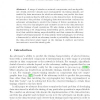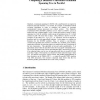117 search results - page 22 / 24 » A Distributed K-Mutual Exclusion Algorithm |
GECCO
2005
Springer
14 years 26 days ago
2005
Springer
Two of the attractions of search-based software engineering (SBSE) derive from the nature of the fitness functions used to guide the search. These have proved to be highly robust...
ESORICS
2009
Springer
14 years 8 months ago
2009
Springer
Abstract. A range of attacks on network components, such as algorithmic denial-of-service attacks and cryptanalysis via timing attacks, are enabled by data structures for which an ...
HT
2009
ACM
14 years 1 months ago
2009
ACM
Data created by social bookmarking systems can be described as 3-partite 3-uniform hypergraphs connecting documents, users, and tags (tagging networks), such that the toolbox of c...
SPAA
2004
ACM
14 years 23 days ago
2004
ACM
Page migration is one of the fundamental subproblems in the framework of data management in networks. It occurs in a distributed network of processors sharing one indivisible memo...
CIAC
2000
Springer
13 years 11 months ago
2000
Springer
A minimum spanning tree (MST) with a small diameter is required in numerous practical situations. It is needed, for example, in distributed mutual exclusion algorithms in order to ...


